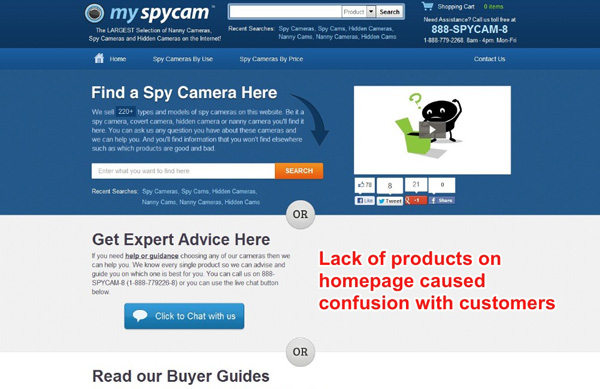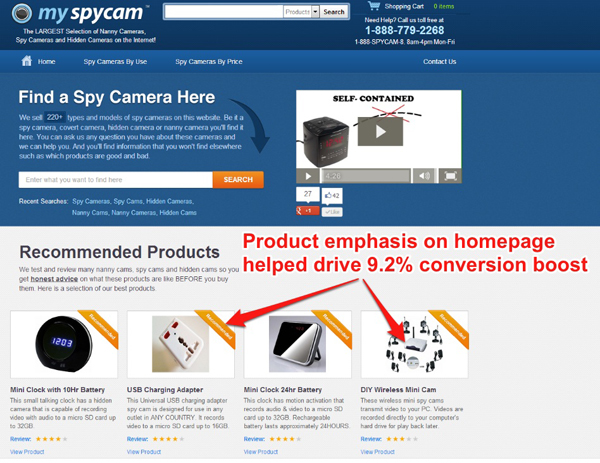
Over the last few weeks I’ve gotten to know reader Kris Kayyal, a conversion rate expert who has been studying user experience and usability online for more than six years. He works with companies to help them increase conversion through a better understanding of their customers. In addition, he also owns his own site selling spy camera equipment where he obsesses over eCommerce conversion optimization.
I’m always striving to offer real-world eCommerce details and so I’m thrilled Kris has agreed to share some conversion optimization tips – and real-world test results – from his own store below.

Test #1 – Watching Customers Use Our Site
Watching recordings of customers interacting with your site can offer deep insights into potential problems and areas to improve conversion. Specifically, I studied customers in the checkout process and visitors who viewed a category page but left before clicking through to a product. Below is an actual video of a customer using my site along with some commentary on the issues I noticed. And yes, I’m fully aware of the irony of spying on folks shopping for spy equipment!
Some of the issues I discovered:
- A bug made agreeing to the “terms and conditions” during checkout confusing
- Lots of people viewed the category page without clicking on a product
- People seemed to be overwhelmed by the numerous filtering options
What I did to address them:
- Fixed the terms and conditions issue
- Added more products on the category page
- Reduced the number of filtering / shopping options
The result? A whopping 36.1% increase in conversions, which is a massive testing (and revenue) win! One of the great things about watching recordings is that is allows you discover problems quickly. Without it, I could have gone for months not knowing that the terms and conditions was causing frustration and cart abandonment.
Here’s how you can duplicate my experiment to increase conversions on your site:
- Sign up for a visitor recording service like MouseFlow or Inspectlet
- Start watching customers interacting with your site
- Make a list of problems you find and improvements you can make
- Implement the changes and measure the result
IMPORTANT: You’ll want to use an A/B testing solution like Content Experiments inside Google Analytics or a paid service like Visual Website Optimizer to confirm that your changes actually improve conversion. It’s important to get validation with hard data vs. going with what you “think” will improves sales.
Test #2 – Understand Our Customers’ Hesitations
One question we frequently received from customers was “How will this purchase show up on my credit card statement?” As many customers use our products in an attempt to catch their spouse doing despicable things (cheating, lying, etc), they’re sensitive as to how the charge will appear on their shared statement. On the phone, we’ve always reassured customers that the charge will be discretely labeled, but we had never communicated that to customers who bought online. And online purchases make up the majority of our orders.
So we decided to test adding the following statement next to the fields for entering credit card information:
“The charge on your card will be discrete and show up as “MSC LLC”
The result of this one minor change? A 13.7% increase in conversions! That’s an impressive boost in sales just for adding one line of text, and it illustrates the power of knowing – and addressing – your customers biggest purchasing hesitations.
Here’s a high-level process you can get started with to do similar work on your site:
- Create a list of what you think are the biggest problems / concerns your customer has
- Sign-up for a service like Qualaroo (formerly Kiss Insights) to collect feedback about visitors’ concerns and buying hesitations
- Identify your customers’ top 2 to 3 concerns
- Brainstorm solutions to solve / alleviate these worries for your customers
- Implement the changes on your site and measure the result
Test #3 – Conducting Usability Testing
Simply watching customers silently use our site (like in Test #1) is useful, but we end up missing out on a lot of valuable data. Specifically, we only see what customers do and not why they do it. To really gain some valuable insights, you’ll want to conduct usability testing which allows you to get real-time feedback from people using your site.
Recruiting your friends and family as test participants is an option, but usually isn’t ideal. Why? They’ll may be too kind with their feedback as they don’t want to hurt your feelings, and probably already are familiar with your business. We want test subjects who don’t know us, will provide honest feedback and aren’t familiar with our site.
There’s lots of options for doing usability testing. A few include:
- Five Second Test – Great for understanding the immediate reaction visitors have of your site. Offer your own opinion to get free tests for your site.
- Feedback Army – For $20 get 10 people to look at your site and answer 4 – 6 questions. Got some quality feedback from this service.
- Try My UI – Listen to a user talk about interacting with your site while watching a recording of them using it. Testers also answer written questions afterward. One free test, then paid.
- Fivver – Loads of people willing to give you feedback on your site for just $5.
- UserTesting.com – Listen and watch as a user talks through the process – and problems – of using your site. $39 / test and you have the ability to request testers from specific demographic (all males, under 30, etc).
- YouEye – Similar to UserTesting, but also offers emotion tracking based on facial recognition software. Wowza! $39 / participant.
I conducted some basic usability testing – particularly focused on our home page – and discovered the following:
- Most people understood that we were in some way related to spy cameras but weren’t sure how
- Some people didn’t realize we were an online store
- People thought our homepage video was an image
- People were turned off by the low share count on our social media buttons
- People found the videos boring and too long
Based on these insights, we made the following changes:
- We reduced the homepage video length
- We removed the Twitter and Facebook buttons
- We made the video more obviously playable
- We added products to the homepage
And the result? These small changes to the homepage resulted in a 9.2% increase in conversion! Not quite as large as the other two, but still a solid improvement especially given our focus on one page. And these changes represented only a handful of items we’ll be working to fix. You can see the difference I made to the homepage below:
Original Homepage

Updated Homepage
Ready for some full-blown usability testing on your own site? Here’s how to get started:
- Sign up with one or more of the providers above.
- Design your test. Plan on asking a list of questions or providing a goal for users to complete.
- Analyze the results and make a list of potential problems / conflicts / confusion points.
- Prioritize making changes based on (1) how easy they are to make (2) how large an impact they will have.
Compounding Improvements
The great thing about conversion optimization is that the improvement you make compound on each other to increase sales. The three experiments I discussed resulted in conversion boosts of 36.1%, 13.7% and 9.2% which you might initially think is an overall improvement of 59.0%. But you’d be wrong! Instead, because each improvement stacks upon the previous one the actual increase in overall conversion is 69.0%! It’s the same concept that makes compounding interest so amazing.
Conversion optimization is powerful stuff. To increase my traffic by 69% would take an enormous amount of work or money. And yet, I was able to increase revenues by 69% relatively quickly with these conversion optimization techniques – a major profitability win.
What successes have you had with A/B testing and conversion optimization? Let me know in the comments below.
Co-written by Kris Kayyal and Andrew Youderian. Photo by 33mhz.




